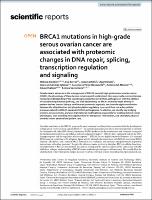BRCA1 mutations in high-grade serous ovarian cancer are associated with proteomic changes in DNA repair, splicing, transcription regulation and signaling
Author
Date
2022-03-15Permanent link
https://hdl.handle.net/11351/8045DOI
10.1038/s41598-022-08461-0
ISSN
2045-2322
WOS
000769466200020
PMID
35292711
Abstract
Despite recent advances in the management of BRCA1 mutated high-grade serous ovarian cancer (HGSC), the physiology of these tumors remains poorly understood. Here we provide a comprehensive molecular understanding of the signaling processes that drive HGSC pathogenesis with the addition of valuable ubiquitination profiling, and their dependency on BRCA1 mutation-state directly in patient-derived tissues. Using a multilayered proteomic approach, we show the tight coordination between the ubiquitination and phosphorylation regulatory layers and their role in key cellular processes related to BRCA1-dependent HGSC pathogenesis. In addition, we identify key bridging proteins, kinase activity, and post-translational modifications responsible for molding distinct cancer phenotypes, thus providing new opportunities for therapeutic intervention, and ultimately advance towards a more personalized patient care.
Keywords
Ovarian cancer; ProteomicsBibliographic citation
Bradbury M, Borràs E, Castellví J, Méndez O, Sánchez-Iglesias JL, Pérez-Benavente A, et al. BRCA1 mutations in high-grade serous ovarian cancer are associated with proteomic changes in DNA repair, splicing, transcription regulation and signaling. Sci Rep. 2022 Mar 15;12:4445.
Audience
Professionals
This item appears in following collections
- HVH - Articles científics [4471]
- VHIR - Articles científics [1751]
The following license files are associated with this item:

 Private area
Private area Contact Us
Contact Us








